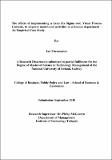| dc.contributor.author | Fitzmaurice, Ian | en |
| dc.date.accessioned | 2011-03-07T15:05:07Z | en |
| dc.date.available | 2011-03-07T15:05:07Z | en |
| dc.date.issued | 2010-08-31 | en |
| dc.identifier.citation | Fitzmaurice, I. (2010), 'The effects of implementing a Lean Six Sigma tool, Visual Process Controls, to improve month-end activities in a finance department - An Empirical Case Study' Unpublished master's thesis, National University of Ireland Galway, Galway, Ireland | en |
| dc.identifier.uri | http://hdl.handle.net/10379/1682 | en |
| dc.description.abstract | The world that companies operate in today forces them to continually seek out and strive for new cost savings and where possible create a competitive advantage. Lean, Lean Thinking and Lean Six Sigma has seen tools and methods applied in manufacturing environments over the years that have proved effective. This dissertation takes one of these tools, Visual Process Controls, and seeks to establish the effects of implementing it so that there is an improvement to month-end activities in an accounting environment. Following extensive research of Lean, Lean Thinking and Lean Six Sigma literature the following two research objectives have been identified for further investigation: Research Objective One: To explore the impact of introducing Visual Process Controls on Pfizer's Grange Castle and Newbridge accounting departments' month-end processes Research Objective Two: To ascertain if Visual Process Controls in use in Grange Castle and Newbridge accounting departments provide clarity of use and clarity of process, and if the monthend visual process control board is an effective process improvement tool for an accounting department environment. The data collection method chosen by the author is qualitative as there is a need to take into account the experiences and views of the analysts, accountants and management within the accounting departments. Semi-structured interviews were carried out with respondents appropriately spread between the various sub-functions of the accounting department to give a fair reflection of the impact and effective use of the month-end visual process control board. The data analysis was both qualitative and quantitative as the author found it necessary to have defined rules for scoring in order to arrive at a conclusion ¿ that the use of Visual Process Control tools within an accounting environment was effective. The researcher achieved research objective one, to explore the impact of introducing visual process controls on the month-end processes within the accounting departments of Grange Castle and ix Newbridge. The research findings indicate many positive impacts across six distinct areas ¿ the month-end process; the finance leadership team; the finance team; team behaviours; tools, systems or processes; and team communication. The research for research objective two, to ascertain if Visual Process Controls in use in the accounting departments of Grange Castle and Newbridge provide clarity of use and clarity of process, and if the month-end visual process control board is an effective process improvement tool for an accounting department environment, have also been achieved. From the twelve respondents interviewed, ten or 83% have deemed the use of the month-end visual process control board to be an effective tool for this environment, based on the defined scoring criteria. | en |
| dc.format | application/pdf | en |
| dc.language.iso | en | en |
| dc.rights | Attribution-NonCommercial-NoDerivs 3.0 Ireland | |
| dc.rights.uri | https://creativecommons.org/licenses/by-nc-nd/3.0/ie/ | |
| dc.subject | Visual Process Controls | en |
| dc.subject | Management | en |
| dc.title | The effects of implementing a Lean Six Sigma tool, Visual Process Controls, to improve month-end activities in a finance department - An Empirical Case Study | en |
| dc.type | Thesis | en |
| dc.description.peer-reviewed | non-peer-reviewed | en |
| nui.item.downloads | 4945 | |


